welcome to worldwidewachs.com
PAGE 2
June 29, 2003
On June 23 we celebrated El Dia de San Juan, the presumed coldest day of the year at the winter solstice.Why we should celebrate the fact that we are freezing to death was a bit hard to fathom, but the Bolivians were being festive about it, so we joined the fun.We went next door to Lucy’s youngest sister Marcella’s house, and roasted hotdogs and chorizos (sausages) and marshmallows.Then, with Andres watching from the kitchen, because he loves the lights, but not the noise, we set off fireworks from the back porch.Like the 4th of July in the U. S., the night sky was popping and cracking, ablaze with colorful, zigzagging lights.It was too late to ask the Virgin de Urkupiña, so I silently prayed to San Juan, just in case he had any influence over the weather.
It’s not that it is so cold, it’s just that there is no way to get warm.Imagine living in temperatures that plummet to 32 degrees at night, but not having a heater, radiator, a warm car, or any source of heat except the sun.Our beds have 2 thick blankets and a comforter, so heavy that when I lie on my back, the ponderous weight of the blankets mashes my toes and forces my feet to the side.But it is warm, and I sleep well.
In the mornings our bedroom is 55 – 60 degrees and the sitting room is 45 – 50 degrees.I take a deep breath, drag myself out of bed, and dress with lightning speed in at least 3 layers of clothing.The sun is intense, and the day warms up gradually, reaching 65 – 70 degrees by noon.But indoors, without the sun, it stays in the 50s or low 60s.In the last 15 minutes of our mid-afternoon walk to Spanish class, striding steadily in the heat of the day, I’m finally down to one layer.But by 4:00 pm in my Spanish class, in a room with open windows and minimal sunlight, I’m donning my third layer.By 5:30 I’m shivering, and when class is over and we start walking home in the dark, my teeth are chattering to Marvin even if I have nothing to say.
At home, our rooms are already 60 degrees or below, and I’m most likely doing whatever I plan to do for the rest of the evening in my bed, under the mounds of blankets.
We began intensive Spanish classes last week – 3 hours a day of private lessons.When you have private lessons, you must pay attention the entire time – no gazing out the window or throwing spit wads at your classmates.Marvin is in a beginner’s class.He’s convinced himself he can’t do this, telling everyone: “I took 4 years of first semester German and can’t say Heil Hitler”, “I’m no good at memorizing and that’s what you have to do with languages”, and “I’d rather have a Berlitz tape infusing me through my pillow at night”.But he’s learning in spite of himself, struggling with the two verbs meaning “to be”, understanding more than he wants to acknowledge, recognizing written words all around him.
I am in a more advanced class with a female teacher who must be half my age.Janet is tall and slender with golden brown skin, wildly curly shoulder-length hair, and wide, smiling eyes.She knows her stuff.And the most important thing I’ve learned thus far is how much I don’t know.My homework essays are riddled with red marks, a busy geometric design of black writing on white paper with generous red squiggles, arrows and circles.“We don’t say it that way”,Janet says.Or “you need to use the definite article here”, or “here, you shouldn’t use the definite article”, or “uh-oh, your subject and verb don’t agree”.
I’m learning about a whole new world of subjunctive.In English, we are apparently much more certain about everything we say. But in Spanish, the strange world of ethereal, every-present subjunctive, every other sentence expresses a wish, uncertainty or possibility that requires using the subjunctive tense.And, of course, the rules are never absolute.You usually use the subjunctive with such and such a phrase, but when it’s not paired with “que”, you only use it if…I’m back in grade school, with a teacher my daughter’s age, who tells me “no, no, no” with that lilting, gradually rising voice that implies I’ve not studied hard enough, and my ignorance is being embarrassingly exposed.
Nevertheless, outside of Spanish class, I seem to be getting along in the world.I get what I order in restaurants, the taxi takes us to our house, not someone else’s when I give the driver directions, and others seem to laugh or nod in all the right places when I’m relating a story or information.So I know I’m getting through to them.Now, I believe that all Cochabambinos must have tremendous mental telepathy powers to be understanding my obviously garbled, ungrammatical, subjunctiveless Spanish.
There is always an unexpected, shimmering delight about a new language when you come upon a word or phrase whose juxtaposition or translation catches you off guard.One of my favorites thus far is: “quehaceres”, which means “chores”, but is literally translated as the “what-to-dos”.I imagine myself on an early Saturday morning turning to Marvin as I gather my things to head out the door, saying “I’m just going to run some what-to-dos¨.Another favorite is “limpiar el polvo” which means “to dust”, but literally translates as “to clean the dust”.It strikes me that here in the perpetually dry, dusty climate of Cochabamba, perhaps they can't actually get rid of the dust, so they settle for cleaning it instead.
Last week we tried to extend our Bolivian visas.The Bolivian consulate in Houston issued us a 30-day visa before we left the U.S., and advised we would have to obtain the 5-month extension here in Bolivia.(By the way, I’m pretty sure the previous sentence contained a subjunctive verb.)The visa process is a complicated, but comical absurdity.And for reasons that will become obvious as I describe the past week, we do not yet have our visa extension, and will become illegal aliens at the stroke of midnight.
Jean Carla hired a professional “visa obtainer” named Chino, and we began our adventure with a trip to SEDES, the university health department, where we needed a blood test for AIDS and Chagas disease (a fatal parasitic disease obtainable right here in Bolivia).Marvin’s blood cooperated perfectly, and exuberantly spurted into the test tube within mere seconds.Meanwhile, the nurse working on me frowned and shook her head repeatedly at my apparently bloodless right arm.Finally switching to my left arm and mumbling strange Spanish words I have not yet learned, she began desperately poking me with her needle. A quarter inch of blood finally dribbled into the tube, then my vein shut down.After some more dismayed Spanishmutterings with Chino and the other nurse at the desk, my nurse extracted the needle, threw away the meager blood sample, and began again with the only section of my left arm that had not yet been attacked.This time my vein yielded almost a half inch of blood before shutting down.Following some extensive frowning, head shaking and consultation, the trio determined the blood sample would be adequate, and the needle was withdrawn.
That painful task over, we proceeded to Interpol, where we needed a certificate to prove we were not international criminals.Interpol first sent us down the street to obtain instant photos.Ten minutes later we were back at the drab, tiny, one-room Interpol office with new photos that provided convincing evidence that we were, in fact, a major criminal liability to the Bolivian populace.Nevertheless, they allowed us to fill out faded forms, then cursorily and incompetently thumb printed us.Finally, they pecked out two official certificates on an old manual typewriter, using carbon paper for copies.
The next stop was the National Police.Apparently an Interpol certificate is not acceptable to the Bolivian police, who require their own “investigation”.However, it was some sort of police and firemen anniversary, and the policemen were all out parading around the Plaza del 14 de septiembre.We waited two days and then returned.
The National Police are more thorough than Interpol.In addition to two thumbprints instead of one, they require written proof of our Bolivian address (including proof of who owns the house and what the most recent electric and water bill is), and a letter from the volunteer organization CEOLI, an organization for handicapped children where we’ll be working.But here we hit another snag, because CEOLI was on a winter break and there was no one to write the required letter.Jean Carla creatively enlisted her father, who is a manager at the Cochabamba Country Club, to certify that we are volunteering at the Club as tree planters.All this was acceptable to the National Police, and we walked away with one more required certificate, also pounded out on a manual typewriter.
That same day we returned to SEDES to pick up our blood test results, and to have a physical exam by the doctor.But SEDES was on a 24-hour strike, and no doctors were working.With illegal alien status looming nearer and nearer, Chino used his network of contacts to obtain two physical exam certificates on in absentia patients.
Along with a lawyer’s certificate and who knows what else, we finally have all the necessary papers to present to the consulate.But it’s the weekend, and the consulate is closed.Thus, our inevitable illegal alien status, when our 30-day visa expires tonight.But not to worry, we met a U.S. embassy official on our flight here from Miami.He gave us his business card, assuring us we could call him for help if we ever ended up in jail.
July 12, 2003
We are no longer illegal aliens.Our passports and papers have been shipped 400 kilometers to LaPaz with the promise of return visas in about 6 weeks.In the meantime, our tenuous hold on legality is a small slip of paper certifying our in-limbo status.But we’ve been assured this is all we need, so we continue going about life in Cochabamba just as though we belong here (not that we could leave anyway).
Two weeks ago we started working in the mornings at CEOLI, a center for handicapped children and young adults.CEOLI is in a questionable part of town, but the facilities themselves are pretty decent for a not-for-profit organization in the heart of the poorest country in South America.Floors are smoothed concrete and outer walls are neat, well-laid brick; inside the tables, chairs and cabinets are a hodgepodge of second and third hand furniture, but everything is creatively decorated.Cardboard storage boxes are covered with wrapping paper or colorful, cut-and-pasted geometric figures; the 28-letter alphabet, complete with accompanying illustrations peers down from the upper part of one wall; an assortment of potted plants dots the stair steps leading to a low-ceilinged loft.
CEOLI is on winter vacation, so the staff is enthusiastically giving the center a makeover.The first day we rearranged the loft.It was chock full of out-dated computer parts, odd-shaped Styrofoam panels, enough children’s drawings to cover all the refrigerators in the civilized world, assorted bottles and cans with mysterious contents, various prosthetic appliances and parts, odd metal pieces of unknown function and origin, and other miscellaneous treasures, all coated with a thick layer of dust.The two rules of rearrangement were:1) move everything to one end and take up one-third of the floor space, and 2) don’t throw anything away!Working feverishly in a dusty haze, we moved things we would have been embarrassed to put in a garage sale.And when the fine brown particles were almost settled, one end had floor-to-ceiling stacks, and at the other end was a nice roomy area, just as requested.
Next, we moved on to wall reconstruction downstairs.Two smaller classrooms directly under the loft were separated from the main area by flimsy masonite walls.As luck would have it, there were two decrepit, dented, dirty wood panels to replace them with.They weren’t exactly the right size, but that didn’t deter us, no sirree!An extra panel of masonite here, a little planning there, and the spaces in between were barely visible to the legally blind.
And then came the painting.For my nephew who works for Sherwin-Williams, this is a stern warning that the next 300 words could cause severe headaches and possibly even strokes.For Marvin and me, it was simply a confounding mystery of painting protocol.Jose, our young, jaunty but conscientious handyman, mixed white oil-based paint with half gasoline, and pronounced it ready for application.Never mind that it was as thin and watery as skim milk, dripping profusely on the cement floor, or that once applied, it was absorbed and disappeared into the woodwork, never to be seen again.
 "Are you sure we need this much gasoline?” we asked, with genuine disbelief.Oh yes, Jose and all the other staff members assured us.It is necessary to keep the paint from drying.You just have to apply several coats.Everyone else was clearly pleased with the concoction, so we proceeded
with the painting.After applying 2 coats, the walls were still almost solid brown, with just a bare hint of some
sort of thin white glaze, as if, perhaps, some soapy bathwater had been cast over them.Ron, the director, and
apparently the resident cheerleader, arrived to admire the improvements, and
crowed about how the area was becoming so much brighter and more attractive.The staff members enthusiastically nodded in agreement.In amazed and puzzled disbelief, Marvin and I stayed silent.Besides, we were now in a gasoline-induced state of euphoria.
"Are you sure we need this much gasoline?” we asked, with genuine disbelief.Oh yes, Jose and all the other staff members assured us.It is necessary to keep the paint from drying.You just have to apply several coats.Everyone else was clearly pleased with the concoction, so we proceeded
with the painting.After applying 2 coats, the walls were still almost solid brown, with just a bare hint of some
sort of thin white glaze, as if, perhaps, some soapy bathwater had been cast over them.Ron, the director, and
apparently the resident cheerleader, arrived to admire the improvements, and
crowed about how the area was becoming so much brighter and more attractive.The staff members enthusiastically nodded in agreement.In amazed and puzzled disbelief, Marvin and I stayed silent.Besides, we were now in a gasoline-induced state of euphoria.
Over the next several days, we lathered those walls with coat after coast of skim milk.After 6 – 7 coats, you could finally tell the walls were meant to be white.There were still occasional streaks of brown showing through, but the intention was at least clear.Ron the cheerleader pronounced it “lindissimo!” (beautiful) and we moved on to painting furniture.
Here, the idea was to jolt your consciousness with color.Every piece of furniture, every chair, table, cabinet and desk was painted with bright red, blue, green, yellow or orange.Jose had moved on to other projects, and the other staff members used a little less gasoline, so the furniture took on a wild array of colors more quickly.At the end of 2 weeks, the rooms are totally changed, vibrantly colorful, and ready for the children’s return.Ron is beyond delighted, and the staff is clearly pleased.And lest our memories of painting fade with time, samples of every color we used are usefully and permanently attached to our work clothes.
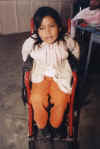 Many staff member
brought their young children with them to work these past 2 weeks. Cecilia, one of the aides, brought Paola (4) and Brayan (1 ½).I would guess Paola has spina bifida; she uses either a wheelchair, or a
walker and leg braces.Otherwise,
she is a normal, curious 4-year-old, asking me questions, wanting me to have
pretend phone conversations with small plastic phones, and telling me she wants
a doll for her upcoming 5th birthday.But I overheard Cecilia telling another staff member that their family of
4 lives in one room, and Cecilia tells me there is no money for birthday
presents.Her goal for Paola’s
birthday is to scrape together enough money to buy a small cake.
Many staff member
brought their young children with them to work these past 2 weeks. Cecilia, one of the aides, brought Paola (4) and Brayan (1 ½).I would guess Paola has spina bifida; she uses either a wheelchair, or a
walker and leg braces.Otherwise,
she is a normal, curious 4-year-old, asking me questions, wanting me to have
pretend phone conversations with small plastic phones, and telling me she wants
a doll for her upcoming 5th birthday.But I overheard Cecilia telling another staff member that their family of
4 lives in one room, and Cecilia tells me there is no money for birthday
presents.Her goal for Paola’s
birthday is to scrape together enough money to buy a small cake.
 How inconceivable is
this?First, that a child wants
only one thing for her birthday?Second,
that even that one small wish will not be fulfilled.How many Christmases and birthdays has our family barely
found a path through the wrapping paper and open cartons of toys, clothes, books
and games?Three days from now, our
granddaughter will receive, on her 3rd birthday, 5 modest presents
from Marvin and me alone.And there
will be others from her mother and father, her aunt, from friends and
great-aunts.There is clearly
something wrong here.Paola only
wants a $4 doll.
How inconceivable is
this?First, that a child wants
only one thing for her birthday?Second,
that even that one small wish will not be fulfilled.How many Christmases and birthdays has our family barely
found a path through the wrapping paper and open cartons of toys, clothes, books
and games?Three days from now, our
granddaughter will receive, on her 3rd birthday, 5 modest presents
from Marvin and me alone.And there
will be others from her mother and father, her aunt, from friends and
great-aunts.There is clearly
something wrong here.Paola only
wants a $4 doll.
July 16, 2003
We are living high on the hog here.A Friday night date for two at the movies, complete with large popcorn and cokes, is $5.The taxi to get there and back approaches 80 cents each way.Marvin got his Minolta X-700 camera fixed, including $25 of parts, for $33.It is only 40 – 50 cents an hour on the computers at the Internet café, and Bolivian wine can be had for less than $2 a bottle.
And not to worry, we splurged on an exceptionally nice doll, complete with fabric cradle, for only $7, and Paola will have a doll for her birthday after all.
We live in luxury at
our house too.There is no
dishwasher and the oven is non-functional, but a maid named Pola does all the
cooking and dishwashing.She also
does our laundry in cold water at an outdoor sink, then rinses using two large
plastic tubs and a garden hose in the back yard.In between filling the tubs, she uses the hose to spray the playful puppy
Bronson, and he jumps and snaps joyfully at the arching stream of water.When Pola is finished rinsing, she hangs our clothes, underwear and all,
anyplace in the back yard where it will dry.In addition to clotheslines, this can include the garden walls and the
trees.Sometimes, from our sitting
room, gazing out over the sturdy southern mountains, the city spread
magnanimously before us, we can catch glimpses of underpants dangling in the
sun.But that’s not all.Our clothes are being ironed for the first time ever – socks,
underwear, everything.Our clothes,
unaccustomed to such regal treatment, are stiff and puffy with pride.
large
plastic tubs and a garden hose in the back yard.In between filling the tubs, she uses the hose to spray the playful puppy
Bronson, and he jumps and snaps joyfully at the arching stream of water.When Pola is finished rinsing, she hangs our clothes, underwear and all,
anyplace in the back yard where it will dry.In addition to clotheslines, this can include the garden walls and the
trees.Sometimes, from our sitting
room, gazing out over the sturdy southern mountains, the city spread
magnanimously before us, we can catch glimpses of underpants dangling in the
sun.But that’s not all.Our clothes are being ironed for the first time ever – socks,
underwear, everything.Our clothes,
unaccustomed to such regal treatment, are stiff and puffy with pride.
But everyone is not as lucky as we are, and there are signs of hard lives and struggle all around us:Indian women with snack kiosks on every corner, their grimy toddlers napping on the sidewalks and playing on the curbs and gutters; the shoe repairman who bids us good afternoon from the sewing machine at his sidewalk workplace; the tiny 8-year-old boys who earn spare change by doing handstands in the street when the traffic lights turn red; the old men who wearily push huge carts laden with oranges around the city, hawking their produce through a tinny loudspeaker.Surely luxury is a relative thing.Having food, a place to sleep, clean clothes and spare change in my pocket makes me feel blessed one hundred times over.
Marvin writes:
Martie, whose thoughts and interests occupy a loftier plane, is reporting on Bolivia from her perspective. I, on the other hand, report on things ignored in polite society.I attribute this to having started at the bottom (at age 4 helping my Grandpa Wachs, who was a plumber) and never rising above my station.Consider yourself suitably warned as I now return to the scene of my last edition, the Throne Room.
Those of us in the U.S. are used to life’s detritus just disappearing. Aside from the occasional op-ed asking, “what are we going to do when the dump fills up?”, or “how about recycling?”, we know the garbage disappears from the curb and everything else takes a swirly.Not so in Bolivia or most of South America for that matter.In Bolivia nothing goes down the toilet but excreta.Next to each toilet is a waste basket, with a lid in the classier places, for toilet paper et. al. Believe me when I tell you it takes focused concentration to overcome years of ingrained habit.I admit to one “oops” in six weeks, an excellent record all things considered.But I was not chagrined enough to retrieve it.
My twisted mental faculties also lead me to wonder if I might be using too much paper or too little.Should I be wadding or folding, or using a French twist?It is, after all, right there for all to see.Might I be offending someone because I am not properly toilet trained?My paranoia asks, might Big Brother be watching? Is my lack of proper etiquette being commented upon by some bureaucrat in an office of waste management?Whom does one ask about such matters?
Our little basket is emptied daily by our maid, and goes out with the trash.Trash is not canned and curbed at individual homes.Rather, every few blocks a local version of a dumpster is placed.These bins seem to be adequately sized for a few days’ worth of trash, but are emptied about once every week or two.I have yet to see a garbage truck in action, although “our” dumpster has been serviced.
Recycle does occur here, but not in the expected way.Each bin is visited by an itinerant group of people who sift through everything, taking whatever is deemed valuable, and as often as not, leaving the rest on the ground.Perhaps the aforementioned bureaucrat is hiding among the scavengers.How desperate must you become to search among the bags of toilet paper to make a living?Local dog packs follow the scavengers, further reducing the volume to be hauled off, while widening the area of overflow.After pick up, where does it go?Stay tuned.
August 9, 2003

 Before
the next work session at the orphanage, Marvin and I take a short trip to a tropical part of Bolivia, first flying to the town of Trinidad to the north,
then going
Before
the next work session at the orphanage, Marvin and I take a short trip to a tropical part of Bolivia, first flying to the town of Trinidad to the north,
then going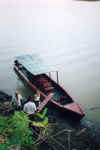 overland to the Rio Mamore, a tributary to the Amazon.To reach the Rio Mamore, we must cross a lesser river by taking a rickety
wooden one-car ferry, pushed by a rowboat powered by a 40 horsepower motor.
overland to the Rio Mamore, a tributary to the Amazon.To reach the Rio Mamore, we must cross a lesser river by taking a rickety
wooden one-car ferry, pushed by a rowboat powered by a 40 horsepower motor.

 We bask for 4 enjoyable days on a pleasure boat, La Reina de Enin (Queen of Enin), putting lazily
up and down the river, reading in hammocks or easy chairs on the deck, studying
the forests and muddy river banks, the few fishing and cattle boats on the river
and the playful pink river dolphins, alighting occasionally to fish or hike in
the villages, or even go horseback riding.In the rainforest or on the riverbanks,
small anaconda.It is a lazy 4 days, languid and slow moving as the river in the hot, beating sun, and a welcome and interesting change of pace.
We bask for 4 enjoyable days on a pleasure boat, La Reina de Enin (Queen of Enin), putting lazily
up and down the river, reading in hammocks or easy chairs on the deck, studying
the forests and muddy river banks, the few fishing and cattle boats on the river
and the playful pink river dolphins, alighting occasionally to fish or hike in
the villages, or even go horseback riding.In the rainforest or on the riverbanks,
small anaconda.It is a lazy 4 days, languid and slow moving as the river in the hot, beating sun, and a welcome and interesting change of pace.
But now it’s an
early, dreary Saturday morning, the leaden gray clouds pressing us down with
their heaviness.Marvin is still in
bed savoring that nothing-special-to-do feeling.We’ve just completed another 2-week work session at the orphanage, and
our bodies are aching tired, a bit beaten and worn down.
nothing-special-to-do feeling.We’ve just completed another 2-week work session at the orphanage, and
our bodies are aching tired, a bit beaten and worn down.
This work session was an Elderhostel group – 7 other absolutely delightful co-workers from various parts of the U. S.We were reunited with Wahana, a woman we worked in Nicaragua with 2 years ago, and it was so good to see her again.The others were Eleanor, Joan, Otis, Robbie, Robert, and Tamayo.All were seasoned travelers, great people and hard workers, and we had an easy rapport, and a cheerful and supportive camaraderie.
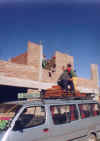 We
began our work where we’d left off 6 weeks ago.
The second floor of the nuns’
We
began our work where we’d left off 6 weeks ago.
The second floor of the nuns’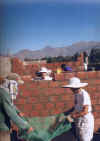 quarters has 4 rooms, 2 alcoves and a
bathroom, creating at least 9 interior walls, which we began constructing with
large hollow bricks.In addition, there was one long outside wall against the dormitory wall, that Otis and Marvin
started with solid regular brick.Between the 9 of us, plus Jean Carla, Felix (the mason) and his helpers Rolando, Jorge
and Sebastian, we were a complex but smooth-working machine in no time, with some people laying bricks, others sifting and carrying sand, mixing cement,
watering bricks, measuring the rows and laying them out.In the afternoons, some of the older orphans, home from
school, would come up to help, with varying degrees of skill and diligence, but always with intense curiosity and eagerness to be a part of such an intriguing
activity.
quarters has 4 rooms, 2 alcoves and a
bathroom, creating at least 9 interior walls, which we began constructing with
large hollow bricks.In addition, there was one long outside wall against the dormitory wall, that Otis and Marvin
started with solid regular brick.Between the 9 of us, plus Jean Carla, Felix (the mason) and his helpers Rolando, Jorge
and Sebastian, we were a complex but smooth-working machine in no time, with some people laying bricks, others sifting and carrying sand, mixing cement,
watering bricks, measuring the rows and laying them out.In the afternoons, some of the older orphans, home from
school, would come up to help, with varying degrees of skill and diligence, but always with intense curiosity and eagerness to be a part of such an intriguing
activity.
Within a few days,
things were going so well upstairs that they needed rebar volunteers.So I moved downstairs and out into the yard.Over the next week and a half, I became halfway proficient in the rebar
world – straightening the 12-meter rods (the hardest, toughest of all the jobs I’ve done thus far), sawing the mea
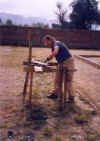 sured
rods, bending the sawe
sured
rods, bending the sawe d rebar into 18 X 28 centimeter rectangles, then laying
out 11-meter columns and wiring on the rectangles every 20 centimeters.Even through my gloves I got blisters, my hands swelled, both thumbs
became painful to even move, and my back and hips screamed with the constant
stooping and kneeling, but I didn’t want to stop.This process caught me up, catching and engaging me like a fascinating
book you just can’t put down. I liked the frustrating process of straightening the long rods, never quite
getting them perfect, but always trying for just a little bit better. I enjoyed the exactness and rhythm of bending the rebar into rectangles, the flush
of pleasure at holding a well-formed one up for inspection.And I took satisfaction in my increasing skill in tying the rectangles to
the columns, making a tight figure 8 with the wire and deftly twisting the knot until the wire reached its tensile limit and broke off.
d rebar into 18 X 28 centimeter rectangles, then laying
out 11-meter columns and wiring on the rectangles every 20 centimeters.Even through my gloves I got blisters, my hands swelled, both thumbs
became painful to even move, and my back and hips screamed with the constant
stooping and kneeling, but I didn’t want to stop.This process caught me up, catching and engaging me like a fascinating
book you just can’t put down. I liked the frustrating process of straightening the long rods, never quite
getting them perfect, but always trying for just a little bit better. I enjoyed the exactness and rhythm of bending the rebar into rectangles, the flush
of pleasure at holding a well-formed one up for inspection.And I took satisfaction in my increasing skill in tying the rectangles to
the columns, making a tight figure 8 with the wire and deftly twisting the knot until the wire reached its tensile limit and broke off.
In the afternoons the kids hovered around us – 8-year-old Ana with her cropped hair and million-doll ar smile, who was too shy to talk, but whose curiosity kept her constantly nearby, 11-year-old Giovanna, who just wanted to quietly hold the wire for me, and who guarded out work space by occasionally giving orders to the younger children when they appeared to be in the way; and 9-year-old Rodrigo, with his bright eyes and impish face, a tireless and diligent worker who would toil silently beside us the entire afternoon.Ever and some of the older boys helped upstairs.The others played in the yard and dropped by from time to time to check on our progress.Nine-year-old Delia, who always wore a short-brimmed knit hat, maybe to distinguish herself from her twin sister Domitilia, helped me saw one afternoon.Three-year-old Joel and four-year-old Maribel occasionally wandered by, wanting to do whatever the older children were doing.They all called us tia (aunt) or tio (uncle), a term Bolivians would also use for an adult who was especially close.
Sometimes, on warm sunny afternoons, working steadily in the yard and listening to the tinkling,
merry laughing and chattering of the kids as they played, you could lull yourself into believing these kids were happy, content
 with
their lot, adequately loved and cared for.They have a spacious dormitory and play / study area now, and a bright,
new cheery dining room.They don’t go hungry – their physical needs are provided for.But when you pick up one of the 3 or 4 year olds and hug him, you find
him board-straight, rigid and unaware of the meaning of human embrace.You notice their hungry eyes when you show them photos of your own
family.And you try to imagine yourself at age 3 or 4, your mother driving you out to the orphanage in a taxi,
pushing you out and never returning.Then you know that beautiful new buildings are only a small part of what these kids
need, and that we have no way to give them the rest.
with
their lot, adequately loved and cared for.They have a spacious dormitory and play / study area now, and a bright,
new cheery dining room.They don’t go hungry – their physical needs are provided for.But when you pick up one of the 3 or 4 year olds and hug him, you find
him board-straight, rigid and unaware of the meaning of human embrace.You notice their hungry eyes when you show them photos of your own
family.And you try to imagine yourself at age 3 or 4, your mother driving you out to the orphanage in a taxi,
pushing you out and never returning.Then you know that beautiful new buildings are only a small part of what these kids
need, and that we have no way to give them the rest.
Our group knocks ourselves out with steady, tireless work. We’re draggy before our 5:00 quitting time,
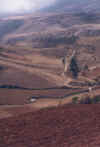 but even so, often stay till 5:15 or 5:30 to finish up.After evening showers and dinner, most group members are asleep between
8:00 – 9:00 pm.Even on the first weekend the pace is hectic.Marvin and I help Jean Carla with shopping for groceries on Saturday, and we check our
Internet messages while the others visit the Cristo statue.On Sunday we leave early for a 4-hour ride to some Inca ruins
at Incallajta.The countryside, powerfully mountainous at altitudes of 9000 – 11,000 feet, is extraordinary and hauntingly beautiful. Cultivated
fields cover the mountain slopes, inching up to the tops, at impossible slants, in unreachable places.Here in the
rural areas, houses are made of adobe, their warm brown sides melting down into the hard brown, rocky earth.This
land is spectacular, angular, reaching forever to the sky.
but even so, often stay till 5:15 or 5:30 to finish up.After evening showers and dinner, most group members are asleep between
8:00 – 9:00 pm.Even on the first weekend the pace is hectic.Marvin and I help Jean Carla with shopping for groceries on Saturday, and we check our
Internet messages while the others visit the Cristo statue.On Sunday we leave early for a 4-hour ride to some Inca ruins
at Incallajta.The countryside, powerfully mountainous at altitudes of 9000 – 11,000 feet, is extraordinary and hauntingly beautiful. Cultivated
fields cover the mountain slopes, inching up to the tops, at impossible slants, in unreachable places.Here in the
rural areas, houses are made of adobe, their warm brown sides melting down into the hard brown, rocky earth.This
land is spectacular, angular, reaching forever to the sky.
A half hour
 before reaching Incallajta, we drop into a more fertile, greener valley.On a narrow cobblestone
before reaching Incallajta, we drop into a more fertile, greener valley.On a narrow cobblestone
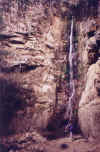 road we follow a small river winding through
just-blooming peach orchards and small lowland farms, eventually climbing back up to the Inca fortress of
Incallajta.It is perfectly situated on a hillside promontory overlooking the river,
with easy views of all the converging valleys.So little is known about this fort; it has been looted and defaced by too
many greedy people who robbed Bolivia of its heritage; and what is left to
excavate still waits patiently beneath the crumbling buildings.But there are remnants of walls and houses, and even a huge temple or
theater, 78 X 27 meters.In the this rays of the sun, and the shifting breezes you can almost feel the ancient
Incas moving amongst you, as if you were the dream and they were the reality.There’s a sacredness in witnessing the remains of such a powerful
civilization.
road we follow a small river winding through
just-blooming peach orchards and small lowland farms, eventually climbing back up to the Inca fortress of
Incallajta.It is perfectly situated on a hillside promontory overlooking the river,
with easy views of all the converging valleys.So little is known about this fort; it has been looted and defaced by too
many greedy people who robbed Bolivia of its heritage; and what is left to
excavate still waits patiently beneath the crumbling buildings.But there are remnants of walls and houses, and even a huge temple or
theater, 78 X 27 meters.In the this rays of the sun, and the shifting breezes you can almost feel the ancient
Incas moving amongst you, as if you were the dream and they were the reality.There’s a sacredness in witnessing the remains of such a powerful
civilization.

The ride back from Incallajta yields different vistas because the clouds have closed in now, hugging the mountains, bathing the world in silvery mists.The same landscape – adobe huts against dry farms against angular mountains – has morphed into haunting, chilly hues of fading browns and muted, watery earth tones.But twice the sun finds its way through, blessing us with huge arched rainbows that stretch their glorious colors forever. This harsh, barely fertile land is breathtakingly beautiful.
The second week of work our bodies
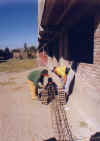 The second week our bodies are dragging, but our willful spirits
prevail. We have walls to finish and more rebar columns to assemble.The 6 de agosto holiday, Bolivia’s Independence Day, is barely a blip on our
radar screen, as we work straight through while the rest of the country celebrates.We catch the evening
parades, and we all wear the red, yellow and green ribbons of the Bolivian flag
to signify our sense of celebration, but we don’t stop working.At the end of the week, the interior walls are finished and
we have built 4 ¾ rebar columns.Jean Carla announces we have well exceeded her expectations, and we beam tiredly. Our job is done, and not a moment too soon.The energy tank is drained.
The second week our bodies are dragging, but our willful spirits
prevail. We have walls to finish and more rebar columns to assemble.The 6 de agosto holiday, Bolivia’s Independence Day, is barely a blip on our
radar screen, as we work straight through while the rest of the country celebrates.We catch the evening
parades, and we all wear the red, yellow and green ribbons of the Bolivian flag
to signify our sense of celebration, but we don’t stop working.At the end of the week, the interior walls are finished and
we have built 4 ¾ rebar columns.Jean Carla announces we have well exceeded her expectations, and we beam tiredly. Our job is done, and not a moment too soon.The energy tank is drained.
The last day is a party with the kids. A magician donates his time to conduct games and puppet
 shows.
shows.
 His wife paints their faces with balloons and hearts and flowers.Tamayo and the kids make colorful construction paper chains and balloons
for the windows.We have piñatas full of candy, and small bags of toys and goodies for each child.And we all play silly games together – sack jumping, stretching elastic
bands around ourselves in relay races.The kids are full of wonderment and beyond excited.It is a party bigger than their wildest dreams, and their faces are
priceless. This party will never make up for being abandoned or parentless, but maybe for a few hours the happiness will predominate.
His wife paints their faces with balloons and hearts and flowers.Tamayo and the kids make colorful construction paper chains and balloons
for the windows.We have piñatas full of candy, and small bags of toys and goodies for each child.And we all play silly games together – sack jumping, stretching elastic
bands around ourselves in relay races.The kids are full of wonderment and beyond excited.It is a party bigger than their wildest dreams, and their faces are
priceless. This party will never make up for being abandoned or parentless, but maybe for a few hours the happiness will predominate.
And then it is finally over.We drift to the trufi, murmuring our various goodbyes.The kids, still clutching their toys and goodies, wave excitedly as we bump our way down the dusty road. We’re drained but happy. We’ve worked hard and given our all, and even though it’s not enough for these deserving kids, it’s a bit more than before, a measure of progress, another thin layer of caring filtering into their lives.
To continue reading click here for page 3 of 3: Bolivia 2003 continues